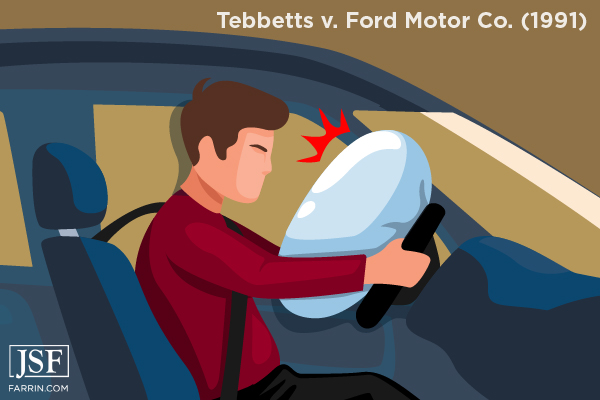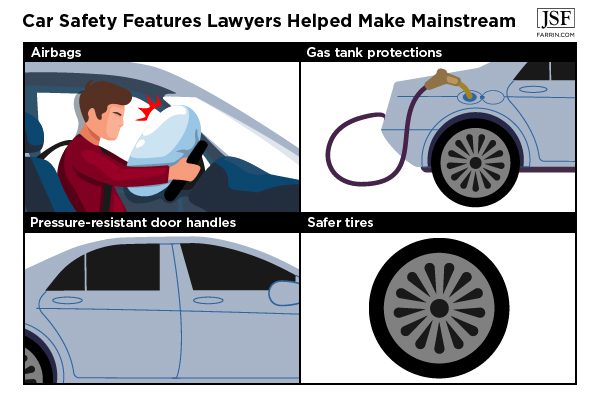Numbers can shift up or down with each passing year, but it’s the long-term trends that really tell us the full picture: Over the decades, the safety of our roads and the vehicles on them has improved over time, but there is much more work to be done.
One thing most people may not be aware of is how we got to where we are now, and just how important litigation was to get us there. Read on for more about what safety measures exist in cars today, and what actions it took to help get us there.
Seatbelt Usage and Other Safety Measures
In 2020, 545 people were killed in North Carolina because they weren’t wearing their seatbelts when they crashed. This is the highest number of unbelted people killed since 2007. In South Carolina, more than 50% of the 717 people killed in car accidents in 2020 were not wearing seatbelts. These stats remind us that we need to remain vigilant when it comes to seat belt awareness and encouragement, and that we should be thankful seatbelts found their way into nearly all vehicles as standard equipment.
Since 2016, the rate of persons injured per 100 crashes in both North Carolina and South Carolina has gone down consistently. In addition to seatbelts, here are some of the other safety improvements in cars through the years that have helped the number of injuries keep declining:
-
- Electronic stability control, which can prevent rollovers
-
- Air bags, which have saved countless lives
-
- Side impact protection, which used to be an afterthought
-
- Strengthened car seats, which used to only come with certain models
-
- Improved roofs, which used to be a critical weak point for many vehicles
So how did these safety features (and more) become standard in almost every car? In many instances, it was attorneys holding car manufacturers accountable in court for their defective products that led the way to significantly safer cars for everyone.
Car Company Priorities
Many times in the history of cars, manufacturers have been aware of catastrophic safety gaps in their vehicles that they could have easily corrected – but chose not to in order to save money. Said another way, some companies may not fix safety problems unless the problem costs more than the solution. Attorneys can make the problem cost a massive amount for negligent manufacturers if they are successful in holding them accountable with large jury verdicts and settlements.
A great demonstration of how litigation can encourage progress in safety measures comes from a short publication from the American Association for Justice (AAJ) called Driven to Safety. Among the many historical examples of defective designs and products from car manufacturers, the report discusses tire safety and the Firestone scandal from the turn of the millennium. At the time, many Ford Explorers had defective Firestone tires that put car drivers and passengers at serious risk. Did Firestone know about this? Of course.
Owners were sending in complaints of tire failure at a massive rate. Employees were reportedly concealing flaws in tires and skipping final inspections altogether. But there was no recall, no investigation by the National Highway Traffic Safety Administration (NHTSA). Only after Firestone was exposed through the civil courts did NHTSA act. After a series of lawsuits on the issue, NHTSA finally opened an investigation. Ultimately, Firestone was forced to recall millions of tires.
The Courts Recognize that Manufacturers Have a Duty of Safety
An early landmark case for car safety litigation was one involving General Motors in the late 1960s. In the case, a victim sued General Motors for severe injuries suffered while driving one of their cars. The man experienced a head-on collision, which caused the steering wheel column to thrust violently backward. The poorly designed steering shaft turned into a fast moving spear aimed at the injured driver’s head.
The response from General Motors at trial? They claimed they had no duty whatsoever to manufacture a car that would be safe during a collision. The car was made to transport people, they said, and it does that. It’s not made to get into crashes, so it’s not a design defect that it’s unsafe when a driver does get in a crash.
Never mind that car accident collisions and crashes are inevitable. Never mind that General Motors knew their defective steering mechanism would hurt and kill lots of people. It wasn’t costing them money in court. Yet.
Finally, the judges in this case stated the obvious. The purpose of a car isn’t transportation, it’s safe transportation. As people died, the legislature did little. It was primarily through the courts that victims were given a means to pressure negligent manufacturers to improve.
Litigation Spurring Safety Innovation
Faulty steering columns is hardly the only example of a car design defect that had to be rectified through the threat and reality of litigation over the years. Here are some examples of others, courtesy of AAJ:
- Ford covered up a problem with its door handles unlatching and releasing car occupants during crashes until pressured by litigation to fix the problem
- Only 2% of new cars came with airbags as late as 1988. It is largely thanks to civil court litigation that airbags became the default in virtually every car
- Many GM and Ford cars used to come standard with defective gas tanks that could explode on even minor contact. Now, your gas tank is generally protected by a sturdy frame
The list goes on. The civil justice system has done at least as much, if not much more, than manufacturers and regulators in making Americans safer when they drive. That’s clear after reviewing only a few safety enforcement accomplishments in relation to cars, let alone other defective products, drugs, and devices people count on to be safe every day.
At the Law Offices of James Scott Farrin, We Take Safety Seriously
We have helped more than 60,000 injured people fight for their rights since we opened our doors in 1997. We have recovered more than $1.6 billion1 in total for our clients – and that compensation has helped many of them begin the healing process and take back control of their lives.
Among our clients are car accident victims, workers who have been hurt on the job, disabled people who are seeking assistance, and people who have been harmed by the negligent actions of others. We believe individuals and organizations should be held accountable for their actions when those actions threaten the safety of others.
If you have suffered from the negligence of another, we can help. Call us at 1-866-900-7078 or contact us online for a free case evaluation.
You May Also Be Interested In
Why Hire a Car Accident Lawyer?








